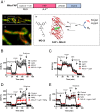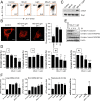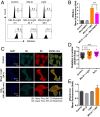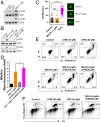Chemoptogenetic damage to mitochondria causes rapid telomere dysfunction
- PMID: 31451640
- PMCID: PMC6744920
- DOI: 10.1073/pnas.1910574116
Chemoptogenetic damage to mitochondria causes rapid telomere dysfunction
Erratum in
-
Correction for Qian et al., Chemoptogenetic damage to mitochondria causes rapid telomere dysfunction.Proc Natl Acad Sci U S A. 2025 Mar 11;122(10):e2501913122. doi: 10.1073/pnas.2501913122. Epub 2025 Feb 20. Proc Natl Acad Sci U S A. 2025. PMID: 39977333 Free PMC article. No abstract available.
Abstract
Reactive oxygen species (ROS) play important roles in aging, inflammation, and cancer. Mitochondria are an important source of ROS; however, the spatiotemporal ROS events underlying oxidative cellular damage from dysfunctional mitochondria remain unresolved. To this end, we have developed and validated a chemoptogenetic approach that uses a mitochondrially targeted fluorogen-activating peptide (Mito-FAP) to deliver a photosensitizer MG-2I dye exclusively to this organelle. Light-mediated activation (660 nm) of the Mito-FAP-MG-2I complex led to a rapid loss of mitochondrial respiration, decreased electron transport chain complex activity, and mitochondrial fragmentation. Importantly, one round of singlet oxygen produced a persistent secondary wave of mitochondrial superoxide and hydrogen peroxide lasting for over 48 h after the initial insult. By following ROS intermediates, we were able to detect hydrogen peroxide in the nucleus through ratiometric analysis of the oxidation of nuclear cysteine residues. Despite mitochondrial DNA (mtDNA) damage and nuclear oxidative stress induced by dysfunctional mitochondria, there was a lack of gross nuclear DNA strand breaks and apoptosis. Targeted telomere analysis revealed fragile telomeres and telomere loss as well as 53BP1-positive telomere dysfunction-induced foci (TIFs), indicating that DNA double-strand breaks occurred exclusively in telomeres as a direct consequence of mitochondrial dysfunction. These telomere defects activated ataxia-telangiectasia mutated (ATM)-mediated DNA damage repair signaling. Furthermore, ATM inhibition exacerbated the Mito-FAP-induced mitochondrial dysfunction and sensitized cells to apoptotic cell death. This profound sensitivity of telomeres through hydrogen peroxide induced by dysregulated mitochondria reveals a crucial mechanism of telomere-mitochondria communication underlying the pathophysiological role of mitochondrial ROS in human diseases.
Keywords: ATM signaling; DNA damage response; mitochondria; singlet oxygen; telomere.
Copyright © 2019 the Author(s). Published by PNAS.
Conflict of interest statement
Conflict of interest statement: M.P.B. is a founder of Sharp Edge Labs, a company applying the FAP-fluorogen technology.
Figures







Similar articles
-
Selective oxidative stress induces dual damage to telomeres and mitochondria in human T cells.Aging Cell. 2021 Dec;20(12):e13513. doi: 10.1111/acel.13513. Epub 2021 Nov 9. Aging Cell. 2021. PMID: 34752684 Free PMC article.
-
DNA double-strand breaks activate ATM independent of mitochondrial dysfunction in A549 cells.Free Radic Biol Med. 2014 Oct;75:30-9. doi: 10.1016/j.freeradbiomed.2014.07.011. Epub 2014 Jul 15. Free Radic Biol Med. 2014. PMID: 25048973 Free PMC article.
-
2-Hydroxyethyl methacrylate-induced apoptosis through the ATM- and p53-dependent intrinsic mitochondrial pathway.Biomaterials. 2014 Mar;35(9):2890-904. doi: 10.1016/j.biomaterials.2013.12.044. Epub 2014 Jan 8. Biomaterials. 2014. PMID: 24411679
-
DNA damage in telomeres and mitochondria during cellular senescence: is there a connection?Nucleic Acids Res. 2007;35(22):7505-13. doi: 10.1093/nar/gkm893. Epub 2007 Nov 5. Nucleic Acids Res. 2007. PMID: 17986462 Free PMC article. Review.
-
Exploring the Link Between Telomeres and Mitochondria: Mechanisms and Implications in Different Cell Types.Int J Mol Sci. 2025 Jan 24;26(3):993. doi: 10.3390/ijms26030993. Int J Mol Sci. 2025. PMID: 39940762 Free PMC article. Review.
Cited by
-
Mitochondrial DNA: cellular genotoxic stress sentinel.Trends Biochem Sci. 2021 Oct;46(10):812-821. doi: 10.1016/j.tibs.2021.05.004. Epub 2021 Jun 1. Trends Biochem Sci. 2021. PMID: 34088564 Free PMC article. Review.
-
Sesquiterpene Lactone Deoxyelephantopin Isolated from Elephantopus scaber and Its Derivative DETD-35 Suppress BRAFV600E Mutant Melanoma Lung Metastasis in Mice.Int J Mol Sci. 2021 Mar 22;22(6):3226. doi: 10.3390/ijms22063226. Int J Mol Sci. 2021. PMID: 33810045 Free PMC article.
-
Molecular Tools for Targeted Control of Nerve Cell Electrical Activity. Part II.Acta Naturae. 2021 Oct-Dec;13(4):17-32. doi: 10.32607/actanaturae.11415. Acta Naturae. 2021. PMID: 35127143 Free PMC article.
-
Mitochondria dysfunction and metabolic reprogramming as drivers of idiopathic pulmonary fibrosis.Redox Biol. 2020 Jun;33:101509. doi: 10.1016/j.redox.2020.101509. Epub 2020 Mar 19. Redox Biol. 2020. PMID: 32234292 Free PMC article. Review.
-
Dual chemical labeling enables nucleotide-resolution mapping of DNA abasic sites and common alkylation damage in human mitochondrial DNA.Nucleic Acids Res. 2023 Jul 21;51(13):e73. doi: 10.1093/nar/gkad502. Nucleic Acids Res. 2023. PMID: 37293974 Free PMC article.
References
-
- Van Houten B., Woshner V., Santos J. H., Role of mitochondrial DNA in toxic responses to oxidative stress. DNA Repair (Amst.) 5, 145–152 (2006). - PubMed
-
- de Moura M. B., dos Santos L. S., Van Houten B., Mitochondrial dysfunction in neurodegenerative diseases and cancer. Environ. Mol. Mutagen. 51, 391–405 (2010). - PubMed
Publication types
MeSH terms
Substances
Grants and funding
LinkOut - more resources
Full Text Sources
Other Literature Sources
Research Materials
Miscellaneous

